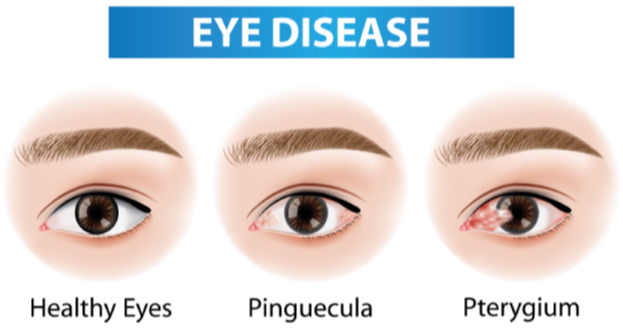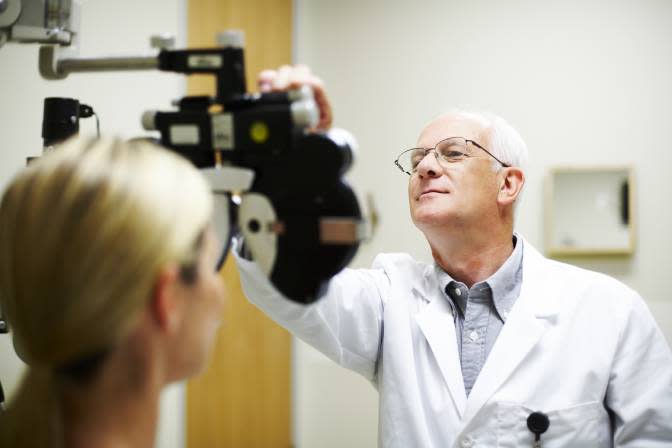Buy one pair of eyeglasses, get a second pair 50% off!
*Restrictions apply. Click here for details.
Pterygium Treatment: Eye Care For “Surfer’s Eye” in North Carolina
Visit the Eye Health Specialists at eyecarecenter

Pterygium is a noncancerous eye condition that affects more than three million people in the United States each year.
Pterygium is often referred to as Surfer’s Eye because it is largely linked to ultraviolet light exposure. This eye condition is most often diagnosed in people who spend a lot of time outdoors. It occurs when a growth of tissue forms on the outer layer of your eye. While it is not a serious condition, a pterygium can cause discomfort and impact your vision.
Our doctors use the most advanced technology available to determine the severity of the condition and provide the best treatment plan for you.
Find Pterygium Treatment at an eyecarecenter Near You

At eyecarecenter, our goal is to provide every patient with their best vision possible. We offer several locations throughout the state of North Carolina including cities like Raleigh, Charlotte, Fayetteville, and Wilmington. Click to find which of our locations is closest to you!
Treatments for Pterygiums
At eyecarecenter, our doctors perform comprehensive eye exams using the latest technology available. Our expert team specializes in eye conditions and can help you determine the best treatment for your unique eyes.
Most pterygiums can be treated using artificial tears (eye drops) or ointments with corticosteroids. Your doctor may recommend surgery if the growth causes extreme discomfort or begins to significantly impact your vision. During this painless, outpatient procedure, your doctor will remove the pterygium and replace it with a conjunctival or amniotic membrane graft. We use amniotic membranes in reconstructive eye surgery because of their biological properties that promote wound healing.
What is Pterygium?
A pterygium is a growth of tissue that can affect one eye or both and people of all ages. It begins on the conjunctiva, the clear outer layer that covers the white part of your eye, and can grow onto the cornea, the part of the eye that helps focus light onto the retina so you can see clearly.
This benign growth forms a triangular shape that is slightly raised and contains blood vessels, often causing irritation and redness. It may appear yellow at first and become flesh-colored over time.
Pterygium is a condition that can cause blurred or double vision if left untreated.
What Are the Symptoms of Pterygium?
Most people can see or feel a pterygium. It generally appears on the part of your eye closest to your nose. Symptoms include redness, itchiness, irritation, a burning sensation, and a feeling like you have something in your eye. A thick or large growth can cover your cornea, which can cause impaired or loss of vision.
Most pterygiums can be treated using artificial tears (eye drops) or ointments with corticosteroids. At eyecarecenter, our doctors perform comprehensive eye exams using the latest technology available to identify and diagnose various eye conditions like Pterygium. We can help you determine whether eye drops, ointment, or outpatient surgery is the best treatment for your unique eyes.
What Causes Pterygium?
A pterygium is a common eye condition that affects millions of people of all ages. Males are twice as likely to be diagnosed with a pterygium than females.
Typically sun exposure and UV light are the main cause of Pterygium. But there are other risk factors including exposure to environmental irritants like pollen, dust, sand, smoke, and wind.
The people who are the most at risk for pterygiums are:
People who spend a lot of time outdoors, especially without wearing sunglasses or eye protection
People who live in warmer climates, on the coast, or close to the equator
People who suffer from dry eyes
Pterygium Risk Factors
To avoid pterygium, wear sunglasses when spending time outdoors to protect your eyes from sun damage and airborne pollutants and use over-the-counter eye drops (artificial tears) when your eyes are dry, red, or irritated.
Common Pterygium Treatments
Pterygium doesn’t always require treatment but may need treatment if it is blocking vision or causing severe discomfort. Eye drops or ointments with corticosteroids may be used to reduce inflammation.
In some cases, getting Pterygium surgically removed may be recommended if prescription-based treatments don’t work. Pterygium Surgery may also be performed for cosmetic reasons.
During this painless, outpatient procedure, your doctor will remove the pterygium and replace it with a conjunctival or amniotic membrane graft. We use amniotic membranes in reconstructive eye surgery because of their biological properties that promote wound healing.
Most pterygiums can be treated using artificial tears (eye drops) or ointments with corticosteroids. Your doctor may recommend surgery if the growth causes extreme discomfort or begins to significantly impact your vision.
Learn About Your Pterygium Treatment Options at eyecarecenter

Pterygium is a common eye condition that can affect all members of your family. At eyecarecenter, we provide expert, compassionate eye care and treat eye conditions for patients of all ages. If you believe you or your loved one may have a pterygium, schedule an exam today!
Frequently Asked Questions About Pterygium
Diagnosing a pterygium is a straightforward process. During an eye exam, your doctor may use a high-powered microscope known as a slit lamp, which allows them to see the eye with the help of magnification and lighting. If your pterygium is not impacting your vision or causing you discomfort, you may not require medical treatment.
Most pterygiums can be treated using artificial tears, steroid eye drops, or ointments with corticosteroids. Your doctor may recommend pterygium surgery, a painless, outpatient procedure if the growth causes extreme discomfort or begins to significantly impact your vision.
Pterygium surgery is a minimally invasive surgery that generally takes no more than 30 minutes. Amniotic membrane transplantation may be recommended to have your pterygium surgically removed. We will work with you to determine the best surgical treatment option for you.
Pterygium affects millions of people each year. It is noncancerous and at times can go away on its own or through medication prescribed by your eye doctor. Depending on your needs, your doctor may recommend an outpatient, painless procedure for cosmetic reasons or to improve your vision.
